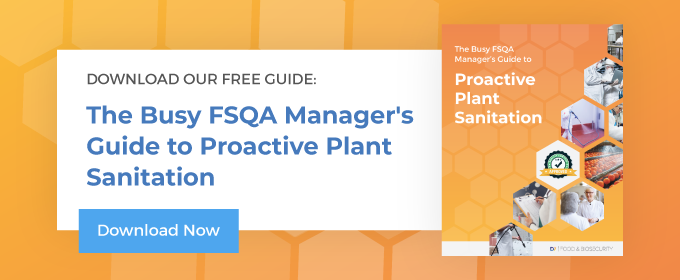Food Safety magazine recently published an article about the importance of cleaning for food safety that highlights the distinction between cleaning and disinfection. This difference is important to understand because without proper cleaning, disinfection won’t be as effective. This can lead to the formation of biofilms that allow bacteria to grow under a protective layer. If that layer is disrupted or allowed to come into contact with food, the result can be an outbreak that affects the health of consumers. Biofilm removal is also a more time- and labor-intensive process than daily cleaning and sanitation, so avoiding this problem in the first place will help save time, money, and lost production.
Cleaning to Remove Soils
Although many people focus on the disinfecting chemicals that kill bacteria in food processing environments, the fact is that physically removing soils is just as important. Before a sanitizer can be applied, surfaces must be cleaned to remove soils. These could include food waste, lubricants, rust, residues, and more depending on the specific application. Removing soils is a physical process, not a chemical one, even though cleaning products might be used. The process often includes sweeping away large debris, washing with a cleaning agent, and rinsing to completely remove the cleaner. In some cases, drying might also be required to remove water and residues before the sanitation step can begin.
Challenges That Lead to Biofilm Formation
A number of factors related to cleaning and disinfection can lead to biofilm formation, such as:
Rushing the process
Food processing facilities focus heavily on production times and make considerable effort to reduce downtimes. Sometimes this can lead to rushing the cleaning process, which can impact the efficacy of sanitizing. Although this might have no negative effects in some cases, even one instance of leaving behind a small amount of bacteria can lead to biofilm formation. This behavior can be curtailed by having clear processes and monitoring to ensure that they are followed every time.
Using incorrect dilutions
Many cleaners come in concentrated form to reduce shipping costs and save on storage space. These are great benefits, but if cleaning crews don’t correctly dilute the products, they can compromise surfaces or leave behind residues, both of which might create opportunities for bacteria to thrive and form biofilms.
Material compatibility issues
It is critical to select cleaning products that are compatible with the materials of the surfaces being cleaned. If work surfaces are damaged or if soils become entrapped because the porosity was affected by a cleaner, the end result could be a haven for bacteria.
Delayed cleaning
When soils are left on surfaces for too long, they can become more difficult to remove. For example, think about leaving dirty dishes in the sink overnight and how much harder it is to clean them the next day—not to mention all that extra time for bacteria to multiply. Minimizing the time between cleaning and processing will help ensure that soils don’t have the opportunity to harden or adhere more strongly to the surfaces being cleaned.
Difficult soils
Some soils are simply more difficult to remove than others. Before creating and implementing a cleaning protocol, make sure you have a good understanding of the types of soils cleaning crews will be addressing. This will help you choose the appropriate cleaning products and equipment to remove all soils before sanitizing.
Residues
Residues from soils and cleaning products can impact the efficacy of sanitizers, which could lead to bacteria being left behind and biofilms forming. The rinsing step is critical for removing residues, so make sure crews spend enough time to do it thoroughly.
Determining cleanliness
Cleanliness can be determined in a number of ways, including conducting visual inspections, using special lighting, and performing ATP tests to detect hidden soils. When training employees, demonstrate the difference between surfaces that are correctly clean and those that are not. When possible, include images in training manuals to ensure that everybody has the same understanding of what clean means.
How D7 Eliminates Biofilm
With many products, biofilm removal requires intense mechanical action to break through the protective layer and reach the bacteria beneath it. Once mechanical action breaks the barrier, the bacterial count will actually of up as the contents inside are released. Only once these released bacteria are cleaned up, does the count go down. This means that crews must use scrubbing tools, extension poles, ladders, and other equipment to reach every surface where bacteria might grow. In contrast, D7 is able to chemically break through and kill bacteria simply by applying a clinging foam and allowing it to stay on surfaces for the recommended contact time. After a potable water rinse, bacteria have been killed and flushed away without a single brush being used.
Remember the Human Element
In addition to using the right cleaning and sanitizing products, crews must be trained to use them correctly. They must also understand the importance of cleaning and that when it is not done properly, sanitizers may not be as effective. Understanding the risks of biofilm formation and the challenges that lead to it will help crews make decisions that lead to better prevention. To stay proactive, read The Busy FSQA Manager’s Guide to Proactive Plant Sanitation to learn more about how to cost-effectively and efficiently prevent bacterial contamination in your facility. If you’re facing a biofilm removal challenge, bring in the experts to help you find a solution. Decon7 is here to help—just give us a call to request a consultation.

